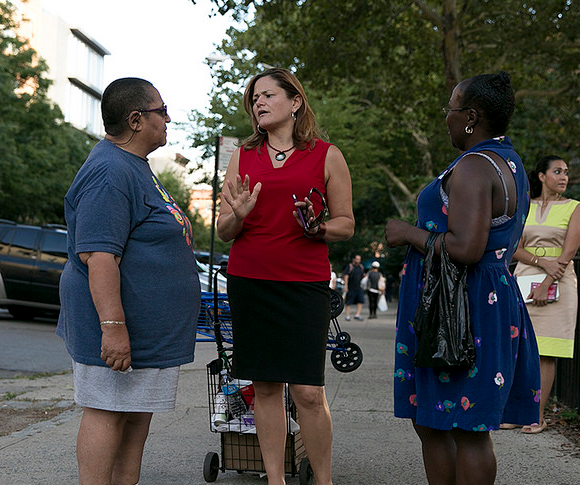 Council Speaker Melissa Mark Viverito has released an “East Harlem Neighborhood Plan” to guide the city’s rezoning of the community, and one of the recommendations is the elimination of parking minimums.
Council Speaker Melissa Mark Viverito has released an “East Harlem Neighborhood Plan” to guide the city’s rezoning of the community, and one of the recommendations is the elimination of parking minimums.
The 138-page plan [PDF] was developed over the past 10 months as a joint project of Mark-Viverito, Community Board 11, Borough President Gale Brewer, and the grassroots social justice group Community Voices Heard. Among its recommendations, the plan calls for “increased density in select places to create more affordable housing and spaces for jobs” and that “any potential rezoning should eliminate minimum parking requirements.”
The parking minimum recommendation is unequivocal and would apply to all housing, not just subsidized housing like the de Blasio administration’s citywide “Zoning for Quality and Affordability” plan. ZQA only eliminates minimum parking requirements for affordable and senior housing development within the so-called “transit zone” — areas that are, generally speaking, a short walk from high-capacity transit.
Mark-Viverito hasn’t taken a position on the parking reforms in ZQA, and her office declined multiple inquiries from Streetsblog on the topic. The City Council is fractured on the issue, but the East Harlem plan indicates that the speaker supports the idea that mandatory car storage is less important than maximizing housing options.
In November, CB 11 rejected ZQA, but it’s not clear where the board stands on parking reforms. The board’s resolution implies that it supports the reduction or elimination of parking minimums for market-rate housing in addition to subsidized housing. Noting that the neighborhood has better transit access and higher density than most of the city, the board said “a finer grained approach to the goals of the transit zones is appropriate in East Harlem, especially as it relates to parking requirements for market-rate housing.”
CB 11 held eight meetings as part of the East Harlem Neighborhood Plan process, and will weigh in on its recommendations before the proposal gets sent to the City Planning Commission.
The East Harlem Neighborhood Plan emerged after de Blasio picked East Harlem as one of the first neighborhoods to be upzoned as part of his housing initiative. Mark-Viverito wanted to lead a public planning process would not only address zoning, but also tackle greater cultural and economic concerns facing the neighborhood. The process began in April and lasted for 10 months, with public meetings held on each of its 12 priorities, which range from “Open Space & Recreation” to “Transportation, Environment & Energy.”
Become a Harlem Insider!
By submitting this form, you are consenting to receive marketing emails from: . You can revoke your consent to receive emails at any time by using the SafeUnsubscribe® link, found at the bottom of every email. Emails are serviced by Constant Contact








